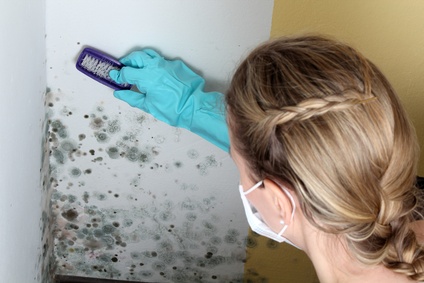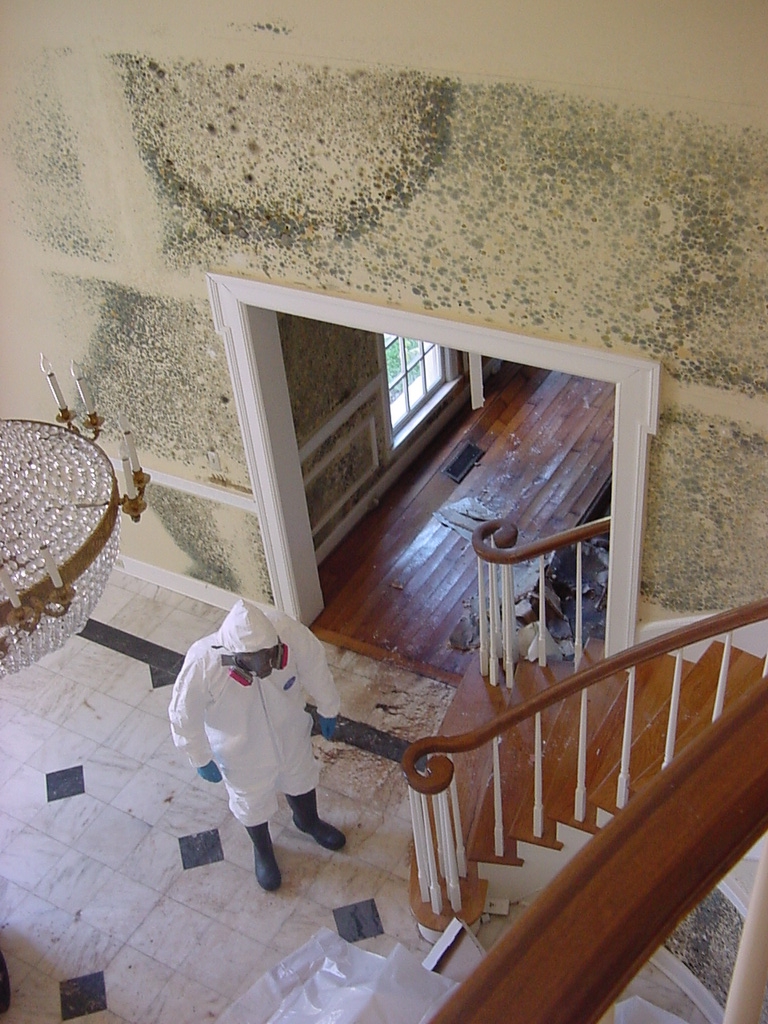What Kills Mold? Bleach vs. Vinegar
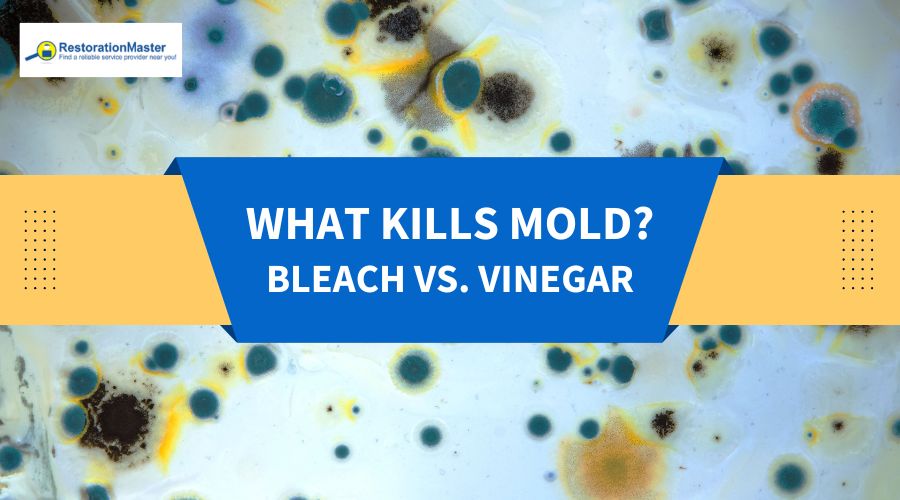
MoldMold is a type of fungus that grows in damp or humid conditi... More is a common yet overlooked issue in many homes. It appears in the most inconvenient places, disrupting your daily routine and creating an ongoing battle to keep your living spaces clean. Not only is moldMold is a type of fungus that grows in damp or humid conditi... More an unsightly nuisance, but it is a serious issue that can pose significant risks.
Below, we will explore whether vinegar or moldMold is a type of fungus that grows in damp or humid conditi... More is a more effective method for killing moldMold is a type of fungus that grows in damp or humid conditi... More to ensure that your home remains a clean and mold-free environment.
The Damaging Effects of Mold
Buildings offer numerous areas that provide the three essential nutrients for moldMold is a type of fungus that grows in damp or humid conditi... More to grow: darkness, moisture, and organic material. These conditions create the perfect environment for moldMold is a type of fungus that grows in damp or humid conditi... More, allowing it to spread quickly and become a persistent problem.
The presence of moldMold is a type of fungus that grows in damp or humid conditi... More can result in extensive property damage and serious health effects for those exposed. MoldMold is a type of fungus that grows in damp or humid conditi... More causes structural damage by feeding on common building materials including wood and drywall. These building materials contain cellulose, an organic material, that moldMold is a type of fungus that grows in damp or humid conditi... More uses as a food source. As the moldMold is a type of fungus that grows in damp or humid conditi... More eats away at these materials, they weaken, increasing the risk of structural damage. MoldMold is a type of fungus that grows in damp or humid conditi... More is also a threat to the areas surrounding the infestations as moldMold is a type of fungus that grows in damp or humid conditi... More disperses its sporesSpores are microscopic reproductive units of fungi or mold t... More.
While property damage is a major concern when dealing with moldMold is a type of fungus that grows in damp or humid conditi... More, the possible health effects are a bigger cause for alarm. The longer you and your family are exposed to moldMold is a type of fungus that grows in damp or humid conditi... More, the risk of experiencing health effects increases. MoldMold is a type of fungus that grows in damp or humid conditi... More exposure can leadLead is a heavy metal that can be toxic to humans, especiall... More to health issues such as:
- Allergic Reactions
- Respiratory Issues
- Sinus Issues
- Lung Infections
Having a prompt response to the sight of moldMold is a type of fungus that grows in damp or humid conditi... More is crucial to prevent the infestation from spreading to other areas as well as causing property damage or negative health effects. If you notice significant moldMold is a type of fungus that grows in damp or humid conditi... More growth in your property, it is best to call professional technicians for mold removal and remediation services. However, if you find smaller amounts of moldMold is a type of fungus that grows in damp or humid conditi... More in your home, you can remove it yourself with household products, such as bleach or vinegar.
Does Bleach or Vinegar Kill Mold?
Bleach and vinegar both have unique properties, making them effective in killing moldMold is a type of fungus that grows in damp or humid conditi... More sporesSpores are microscopic reproductive units of fungi or mold t... More. Vinegar, a mild acid, removes moldMold is a type of fungus that grows in damp or humid conditi... More from porousPorous describes a material that contains small openings or ... More materials like wood, drywall, and fabrics by disrupting the mold’s cellular structureStructure refers to the framework or components of a buildin... More. This way of removing moldMold is a type of fungus that grows in damp or humid conditi... More is preferred and recommended very often, as it is safer and more efficient in killing moldMold is a type of fungus that grows in damp or humid conditi... More by penetrating the porousPorous describes a material that contains small openings or ... More materials.
On the other hand, bleach is a strong disinfectantA disinfectant is a chemical substance used to kill or inact... More that can kill moldMold is a type of fungus that grows in damp or humid conditi... More growth on non-porous materials such as glass, tile, and metal. Bleach destroys the mold’s organic material and has a higher PH, inhibiting moldMold is a type of fungus that grows in damp or humid conditi... More growth. Since bleach is better for non-porous materials, it only cleans the surface of affected materials. If you use bleach to remove moldMold is a type of fungus that grows in damp or humid conditi... More growth, there is a good chance that the moldMold is a type of fungus that grows in damp or humid conditi... More will return.
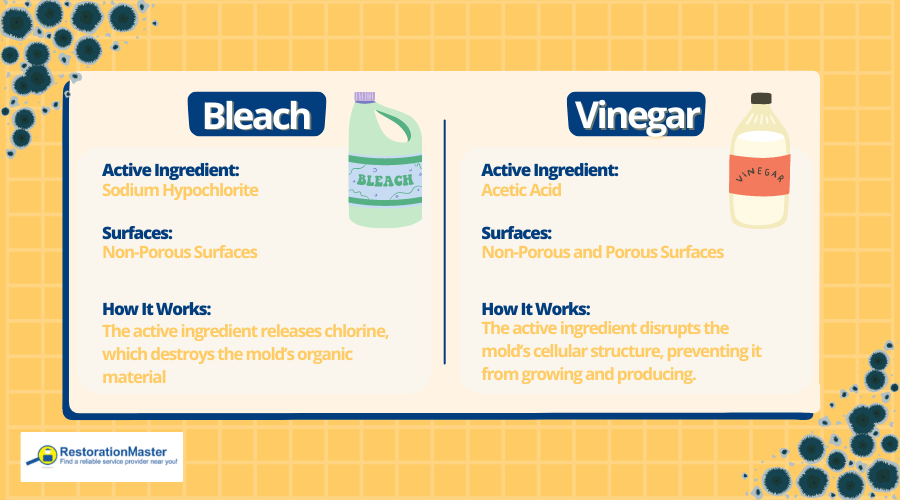
Removing Mold with Bleach
According to conventional wisdom, bleach kills moldMold is a type of fungus that grows in damp or humid conditi... More growth. However, bleach only kills the moldMold is a type of fungus that grows in damp or humid conditi... More on the surface without affecting the membrane underneath. To effectively remove moldMold is a type of fungus that grows in damp or humid conditi... More growth and prevent it from returning, the underlying membrane needs to be killed and removed. Bleach cleaners are not able to kill this membrane, as its chemical structureStructure refers to the framework or components of a buildin... More prevents it from penetrating porousPorous describes a material that contains small openings or ... More surfaces. For bleach to be beneficial in removing moldMold is a type of fungus that grows in damp or humid conditi... More, it should be used to remove small amounts of moldMold is a type of fungus that grows in damp or humid conditi... More that have formed on non-porous surfaces.
Another issue with using bleach is that it can promote moldMold is a type of fungus that grows in damp or humid conditi... More growth. When bleach comes into contact with mold colonies, the moldMold is a type of fungus that grows in damp or humid conditi... More may recognize it as a threat and respond by using it as a food source. This reaction can cause the moldMold is a type of fungus that grows in damp or humid conditi... More to grow back more quickly and aggressively. Even the EPA advises against using bleach for moldMold is a type of fungus that grows in damp or humid conditi... More removal.
Removing Mold with Vinegar
Vinegar is an effective and versatile solutionA solution is a homogeneous mixture of two or more substance... More for removing moldMold is a type of fungus that grows in damp or humid conditi... More from various surfaces. As a mild acid, it can kill 80% of moldMold is a type of fungus that grows in damp or humid conditi... More species commonly found in homes and also assist in preventing moldMold is a type of fungus that grows in damp or humid conditi... More. When using vinegar to remove moldMold is a type of fungus that grows in damp or humid conditi... More, follow the steps below to ensure you are being safe and efficient.
- Prevent exposure to the moldMold is a type of fungus that grows in damp or humid conditi... More by wearing protective gear such as gloves and a mask.
- Pour white distilled vinegar into a spray bottle. Avoid diluting the vinegar, as this will reduce its effectiveness.
- Spray the vinegar directly onto the moldy areas.
- Let the vinegar sit for at least one hour to allow the acid to penetrate and break down the moldMold is a type of fungus that grows in damp or humid conditi... More.
- Use a cleaning brush or a spongeA sponge is a porous material used to absorb liquids or clea... More to scrub the moldy area, removing the moldMold is a type of fungus that grows in damp or humid conditi... More residueResidue is any leftover material, such as soot, dust, or che... More.
- Wipe away any remaining vinegar or moldMold is a type of fungus that grows in damp or humid conditi... More residueResidue is any leftover material, such as soot, dust, or che... More using a clean cloth or rag. You may need to rinse the area using warm water to fully remove the vinegar.
- Dry the surface completely using a dry cloth or towel. MoldMold is a type of fungus that grows in damp or humid conditi... More thrives in damp environments, so ensuring that the area is fully dry helps prevent moldMold is a type of fungus that grows in damp or humid conditi... More growth.
- Repeat these steps as necessary, or consider reaching out to mold removal professionals.
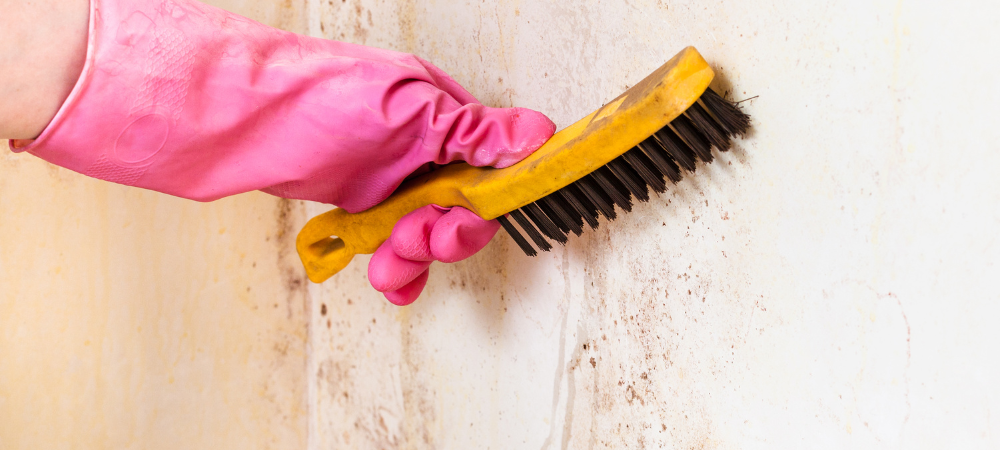
Removing Mold from Your Home
Removing moldMold is a type of fungus that grows in damp or humid conditi... More from your home can be a challenging task, especially if the infestation is extensive or persistent. While using vinegar or bleach can be effective for smaller, isolated areas, larger moldMold is a type of fungus that grows in damp or humid conditi... More problems often require professional assistance. MoldMold is a type of fungus that grows in damp or humid conditi... More can spread quickly and hide in hard-to-reach places, making it difficult to fully remove without the necessary methods and equipment.
If you find that moldMold is a type of fungus that grows in damp or humid conditi... More keeps returning despite your efforts or that it is widespread, it’s wise to consult with a professional mold remediation service. These experts have the tools and knowledge to assess the extent of the problem, safely remove moldMold is a type of fungus that grows in damp or humid conditi... More, and address underlying issues to prevent future outbreaks. Ensuring a thorough and effective moldMold is a type of fungus that grows in damp or humid conditi... More removal process is crucial for protecting your home and your health.










